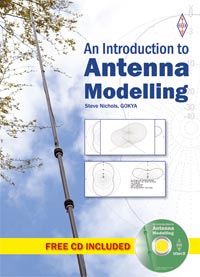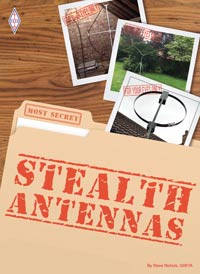 Latest News, 15-3-17: Fred is still making the antenna. He said: "Steve - I am still making the HF-10. I did stop for a while due to an illness. I don't sell them any more on Ebay. I can't keep up with demand. What I sell now comes through word of mouth. The price is £85 including special delivery."
You can contact Fred via m0bzi@outlook.com
Latest News, 15-3-17: Fred is still making the antenna. He said: "Steve - I am still making the HF-10. I did stop for a while due to an illness. I don't sell them any more on Ebay. I can't keep up with demand. What I sell now comes through word of mouth. The price is £85 including special delivery."
You can contact Fred via m0bzi@outlook.com
The Western HF-10 multiband dipole was born out of Fred Western M0BZI's attempts at working 80m from a small garden. His basic design starting point was the half size G5RV, to which he added inductors on each leg. Unhappy with the results, he then played around with the overall length and added a balun at the feedpoint.
The end result is the antenna as now supplied.
Specifications
The Western HF-10 is a 67 feet long dipole/doublet. It incorporates two loading coils placed towards the end of the legs and has a 15 foot 3 inch section of 450 Ohm windowed ribbon feeder to the centre feed point. At the end of the 450 Ohm feeder a ferrite rod balun is fitted for the transition to 50 Ohm coax. This appears to be wound as a 4:1 impedance transformer.
The build quality is excellent and all fittings are stainless steel. The balun housing is substantial and all crimped joints are very strong and designed so that they don't stress the antenna.
The antenna wire is Flexweave, which is both strong and easy to work with.
Installation
For the test I installed the antenna an an inverted V with the apex at about 30ft and the ends at about 10 feet.
Out of the box the antenna was found to be resonant at 3.7MHz.
Initial SWR tests were done using a 15ft length of RG58 coax to an MFJ analyser. Subsequently, a further 60ft of RG213 was added to bring the end into the shack. The subsequent SWR readings with the additional length of coax are shown in brackets.
SWR measured with MFJ 269 antenna analyser at end of 15ft RG58 coax (and at end of 60ft RG213 coax)
1.9MHz: 31 (10.8:1)
3.5MHz: 3.7:1 (5.5:1)
3.7MHz: 1.2:1 (1:1) resonant point
3.8MHz: 4.3:1 (3.9:1)
7.0MHz: 6.2:1(3.3:1)
7.1MHz: 6.2:1 (3.3:1)
10.1MHz: 6.1:1 (3.2:1)
14MHz: 2.5:1 (1.6:1)
18.1MHz: 4.8:1 (2.7:1)
21MHz: 4.6:1 (2.3:1)
24.9MHz: 3.6:1(2.3:1)
28MHz: 1.2:1 (1.2:1)
29MHz: 1.9:1 (1.4:1)
50MHz 1.7:1 (1.5:1) – actually resonant at 48.6MHz
As can be seen, the SWR appears to go down once the additional coax is added. This is normal and is due to losses in the coax. Out of the box the antenna is naturally resonant on 80m, 20m and 10m.
The internal ATU on my Icom 756Pro 3 was able to find a 1:1 match on all bands 80m – 6m quite easily. Fred had said that his Yaesu FC-902 was also able to match the antenna on 160m, but the SWR was outside of the tuning range of my internal ATU.
Nevertheless, my external ATU was used to find a match on 160m, despite the antenna's short length.
First impressions
The antenna was mounted away from the house and fed via a 10 turn coax choke balun. This, plus the antenna's own balun resulted in a very quiet installation from a noise point of view.
With today's electrically noisy urban and suburban environments this was a breath of fresh air and made it that much easier to hear weak signals. The balanced design meant that there were NO detectable currents on the braid of the coax at all.
I had my doubts about the design of the antenna. It is very hard (if not impossible) to make a multi-band dipole that is coax fed and that will work on all bands. The Off Centre Fed Dipole (Windom or OCFD) is one design that gets close, but other designs (including the G5RV) fail to give a good match on all bands.
The problem is that they often display poor matches on many bands. The resultant poor SWR is often masked by coax losses on long runs, giving apparent better SWRs in the shack at the expense of losses in the coax caused by high SWR. This is why I did the initial SWR tests using a short length of coax.
Louis Varney G5RV himself also experimented with baluns at the open wire feeder/coax junction but abandoned the idea as the varying reactance at that point can lead to balun saturation and more losses/poor behaviour.
So I was interested to see how this model performed.
Performance
160m
I was able to tune the Western HF-10 on Top Band using an external ATU. The SWR is way too high for an internal ATU to match it on that band. Despite the antenna's short length I was able to work and hear UK stations, but signals were well down, typically around S5 compared with S9+10dB on my Windom (which itself is too short for Top Band). Nevertheless, if you only have room for a 67ft antenna it will let you experience the band. Noise levels were, once again, very low.
80m
The antenna's 80m performance was compared with an 85ft W3EDP and a 135ft home made OCFD (Windom) with a 4:1 balun, both with an apex at about 30 ft. I know exactly how these perform, having been using them in the RSGB's 80m Club Championship for three years. Best 80m DX on the OCFD has been VP8 Falkands and numerous US stations.
The antenna's noise level on 80m was found to be about three S points better than my existing antennas. This was because a) the Western HF-10 was situated further away from the house and b) it has an effective isolating balun.
The offset nature of my OCFD means that it is prone to picking up noise on the feeder, despite a choke balun.
Signals from around the UK and Europe were generally found to be equal to or 1-2 S points down when received on the Western. This was to be expected as the antenna is only half the length of the Windom. The lower noise level however made it easier to hear people.
These results were fairly consistent – the difference was always between 0 and 10dB down. This isn't as bad as it sounds – signals that were S9 +20db on 80m might become S9 + 5-10dB. It was only very weak signals that were marginal.
The low noise levels did make for easier listening though. I received a 59 +20db report from MJ0CTR in Jersey - what more could you ask for? At the time of testing (August) no 80m DX was heard.
40m (7MHz)
It was a similar story on 40m. EU signals were in general 1-2 S points down compared with the 136ft OCFD/85ft W3EDP, but lower noise levels made for easier listening. Some signals from DL were the same signal strength on all the antennas. Some were actually stronger on the Western.
30m (10MHz)
Again, lower noise was the order of the day. My OCFD is not really optimised for 30m and the Western outperformed it by up to 2 S points on CW around EU. A good antenna for this band.
20m (14MHz)
Signal strengths from Europe were roughly equal to the other antennas. This was apparent on many signals and was not a one-off. Some signals were stronger on the Western by up to 2 S points. Tests with stations in VO1 and VE9 on 14MHz showed the antenna outperformed my existing antennas. This was the case too with a short skip contact with Jon GM3JIJ on the Isle of Lewis. This antenna really shines on 20m.
17m (18MHz)
Signals were once again roughly equal to my OCFD, but sometimes up to 2 S points weaker than on a dedicated 17m dipole. Noise levels were once again better. Switching between the two you could see the effects of polarisation shifting in the ionosphere as one and then the other antenna became louder.
15m (21MHz)
My Windom does not really work on 21MHz. I normally switch to the W3EDP or use a 40m dipole. The Western outperformed both.
12m, 10m, 6m (21MHz, 24MHz, 28MHz and 50 MHz)
I managed to find a few Es signals on 10m a few days after I wrote the original text. They were all down about 2-3 S points on the Western compared with a dipole and the Windom.
General Coverage
I couldn't help but try the antenna out on the Broadcast Shortwave/Medium Wave bands. It was capable of picking up BBC Radio Wales from Washford in Somerset on 882kHz in daylight hours ( I live in Norfolk), although my other antennas were louder.
All of the stations I heard on the 7MHz, 9MHz, 11MHz, 15MHz were roughly all the same signal strength on both antennas. All India Radio on 6280kHz was down 20dB compared with my Windom.
Update: March 2014
This review was written a couple of years ago. People have asked about the antenna's 60m (5MHz) performance. Although I didn't test it at the time the consensus from other people who have contacted me is that the antenna doesn't work well on this band.
Conclusions
I was very impressed with the Western HF-10. My first reaction was that it must be a bit of a compromise as it is only truly resonant on 80m. And yes, signal strengths were down a little overall. But the low noise characteristics of the antenna, and the fact that it could be persuaded to match on all bands 160 - 6m made it very usable.
On 20m the antenna matched or bettered my others in terms of performance, but with lower noise, which was a bonus.
You obviously trade off some performance on some bands compared with dedicated dipoles for each band, but this was never more than about 2 S points at worst (apart from Top Band). However, the low noise characteristics make up for this as I was often able to hear signals on the Western that were in the noise on my other antennas.
Given that these were also longer it shows how useful the Western HF-10 can be, especially if you do not have room for a full 80m antenna.
It also worked well on the shortwave broadcasts bands above about 4MHz.
For someone looking for an antenna that will fit in a small back garden, but will allow them to work all the HF bands, the Western HF-10 has a lot to offer.


























